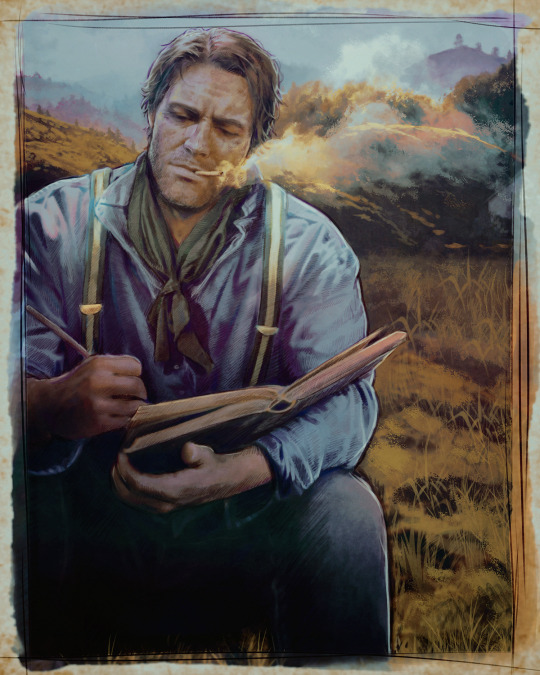Text

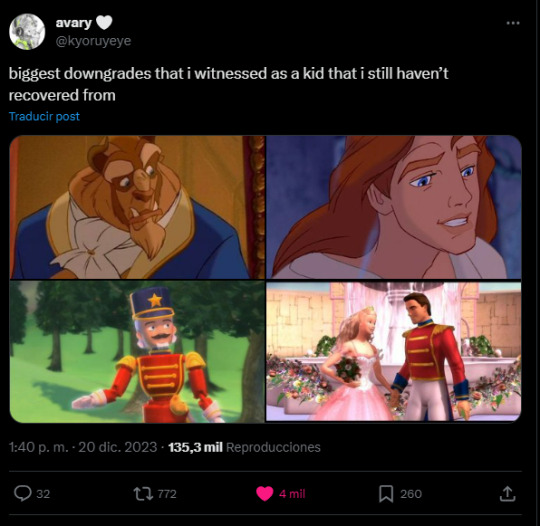
Fast doodle of the adventure-loving besties and their turned-human hubbies ♥
7K notes
·
View notes
Text




✨✨STICKERS✨✨
in my ko-fi shop on:
Friday the 14th of June!! 14/06/24
6PM UTC+2
Thank you for all your support!<3
1K notes
·
View notes
Text
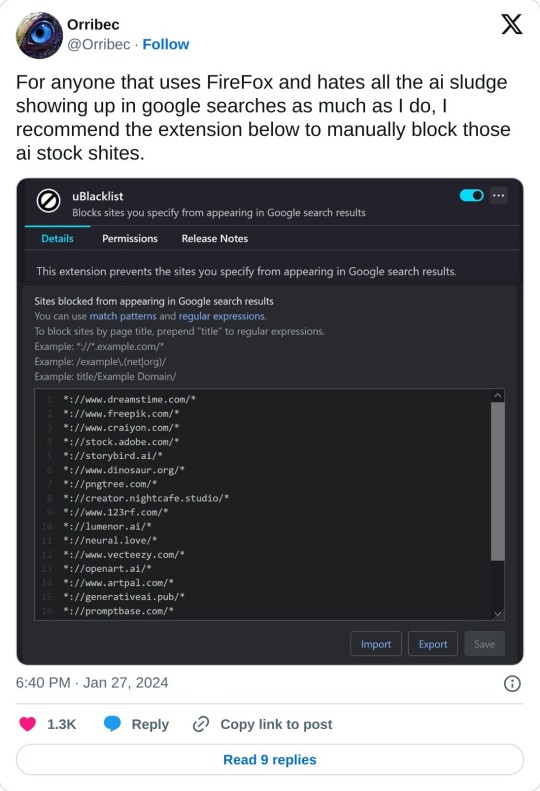
://www.dreamstime.com/
://www.freepik.com/
://www.craiyon.com/
://stock.adobe.com/
://storybird.ai/
://www.dinosaur.org/
://pngtree.com/
://creator.nightcafe.studio/
://www.123rf.com/
://lumenor.ai/
://neural.love/
://www.vecteezy.com/
://openart.ai/
://www.artpal.com/
://generativeai.pub/
://promptbase.com/
Block these sites in your uBlock Origin so you won't see that shit in your searches
72K notes
·
View notes
Text
I recently had surgery, and at the time I came home, I had both my cat and one of my grandma's cats staying with me.
- Within hours of surgery, I wake up from a nap to my cat gently sniffing at my incisions with great alarm.
- I was not allowed to shower the first day after surgery, and the cats, seeing that The Large Cat is not observing its cleaning ritual, decided I must be gravely disabled and compensated by licking all the exposed skin on my arms, face, and legs.
- I currently have to sleep with a pillow over my abdomen because my cat insists on climbing on top of me and covering my incisions with her body while I sleep (which is very sweet but not exactly comfortable without the pillow). She also lays across me facing my bedroom door, presumably on guard for attackers who may try to harm me while I'm sleeping and injured.
That's love. 🐈⬛🐈❤️
162K notes
·
View notes
Text
Demons and monsters that torture people because they feed on human suffering are so dumb. People are suffering everywhere my guy go literally any place and take a deep whiff.
133K notes
·
View notes
Text

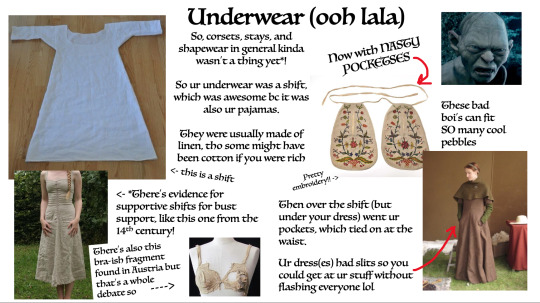
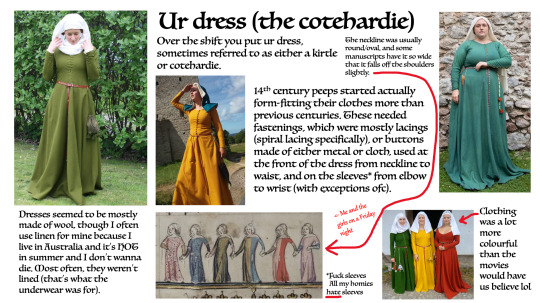
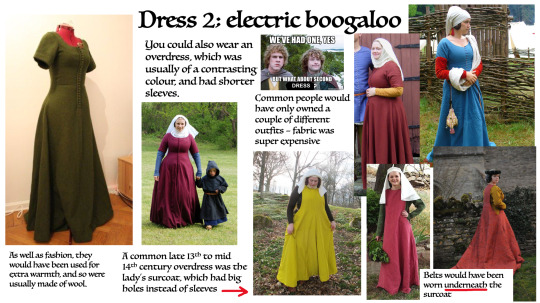



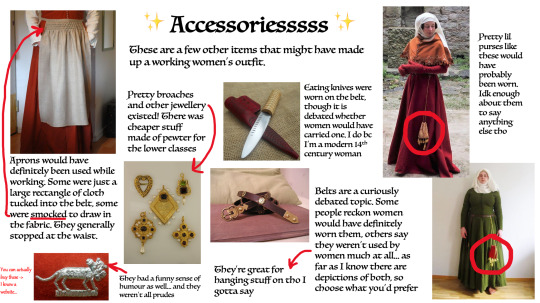
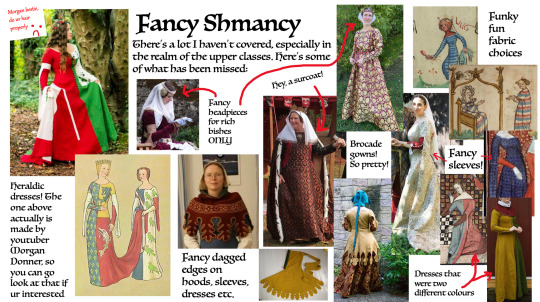
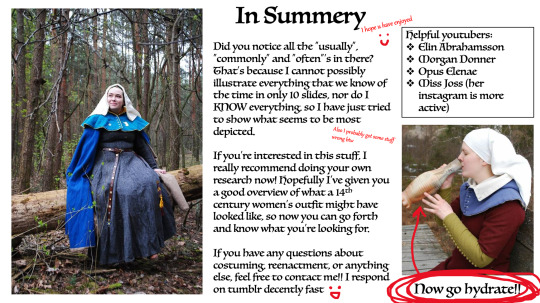
If you’re on mobile, you may have to click on the images for better quality!
Plain text version with image descriptions is under the cut.
Please note that the image descriptions will be reflecting what I am trying to convey with the photo, rather than the total look of the photo itself. For example if I am trying to describe a dress, the hair colour of the person wearing it will be ignored. This is to reduce the total word count of the descriptions, because I have a lot of images to describe. On this note, I have also streamlined the information as much as possible.
[Plain text description:]
First slide: Mariota’s Guide to 14th Century (Medieval) Women’s Clothing
This slideshow is brought to you by @the-merry-otter on tumblr
ALRIGHT LISTEN UP MOTHERS AND FUCKERS. I’m bored, so today we’re going to be talking about medieval clothing. Specifically fourteenth century English clothing because that’s what I’m good at. (Source: trust me bro I’m a reenacter). Also this is all female stuff - sorry masc leaning folks, I’ll get to you someday!
Disclaimer: this is not completely comprehensive or nuanced in the slightest, it’s just a quick overview guide. Do your own research xoxo.
[Image ID: to the left is a picture of a woman in a light blue dress and a pink hood gazing out at a lake. The hood has a skirt that falls over her shoulders, and there is along thin pipe attached to the back of the hood that dangles to her knees. The edges of the hood are decorated with burgundy crochet. The picture is captioned “beautiful, stunning, gorgeous, literal goals.” End ID]
[Image ID: To the right is a picture of a typical renn faire outfit. It has a white poofy underdress, a black corset, and a brown skirt. There is a red cross drawn over the image. It is captioned “very pretty, but definitely not medieval sorry!” End ID]
Second slide: Underwear (ooh la la)
Now with nasty pocketses
[Image ID: a picture of gollum, from lord of the rings, snarling in disgust. There is a line in The Hobbit where he asks Bilbo what he has in his nasty little pocketses, which is what I am referencing. End ID]
So, corsets, stays, and shapewear in general kind of wasn’t a thing yet. So your underwear was a shift, which was awesome because it was also your pajamas. They were usually made of linen, though some might have been made of cotton is you were rich.
[Image ID: A plain white linen garment laid out flat on the floor. It is a dress that hangs to about knee length, with elbow length sleeves. An arrow points to it with text reading “this is a shift”. End ID]
There is evidence for supportive shifts for busy support, like this one from the fourteenth century!
[Image ID: a second shift, worn by a female presenting person. It is laced up the front, and is a lot tighter and more fitted, especially around the bust. It has straps instead of sleeves. End ID]
There’s also this bra like fragment found in Austria, but that is a whole debate so.
[Image ID: A bra-like garment fitted to a mannequin. It seems to be made out of white linen, coloured with time. The left cup is damaged, and overall the garment looks incomplete. End ID]
Then, over the shift, yet under your main dress went your pockets, which tied on at the waist. Your dresses had slits do that you could get at your stuff without flashing everyone lol.
[Image ID: A picture of medieval pockets. They are upside down teardrop shaped, but the point is flat and is part of the waist ties. There are slits in the side up the top to access the inside. They are cream coloured with bright floral embroidery. The caption reads “these bad boys can fit so many cool pebbles.” End ID]
[Image ID: A young female-presenting person wearing medieval clothing. She has her hands in the pocket slits of her dress. They are just below hip height. End ID]
Third slide: your dress, or the cotehardie. (Pronounced coat hardy)
Over the shift you put your dress, sometimes referred to as either a kirtle or cotehardie. 14th century people started actually form-fitting their clothes more than previous centuries. These needed fastenings, which were mostly lacings (spiral lacings specifically), or buttons made of either metal or cloth, used at the front of the dress from neckline to waist, and on the sleeves from elbow to wrist, with exceptions of course.
(Sidenote: fuck sleeves, all my homies hate sleeves)
[Image ID: a woman in a warm yellow dress to the left of the text. The dress is constructed simply, with a single piece of fabric used for the length of the body so there is no waist seam. The skirt is widened by inserting four triangles, one each at the front and back, and one on each side. The front has buttons made of the same fabric as the dress, that go down to the belt at the waist. The sleeves have similar buttons from wrist to elbow, on the outside of the arm. The woman is also wearing a liripipe hood. End ID]
Dresses seemed to be mostly wool, though I often use linen for mine because I live in Australia and it’s hot in summer and I don’t want to die. Most often they weren’t lined (that is what the underwear was for).
[Image ID: in the top left of the slide is a woman wearing a green woollen dress. It is constructed the same as the previous image, except it has spiral lacing on the front instead of buttons. The sleeves are fastened by three small buttons. She is wearing a simple and veil. End ID]
[Image ID: the top right of the slide shows a woman in a teal coloured dress, similar to the one before. This one has metal buttons at the sleeves and down the front. She wears a veil only. End ID]
The neckline of these dresses was usually round or an oval shape, and some manuscripts have it so wide that it falls off the shoulders slightly.
[Image ID: A photo of a medieval manuscript, depicting six medieval ladies in a row holding hands. The neckline of their dresses is wide enough that the tops of their shoulders are visible. The image is captioned “me and the girls on a Friday night”. End ID]
Clothing was a lot more colourful than the movies would have us believe lol.
[Image ID: Three women, each in dresses similar to the ones before. To the left is a forest green, the middle one is bright saffron yellow, and the one to the right is a vibrant tomato red. End ID].
Fourth slide: Dress two; electric boogaloo
[Image ID: Merry and Pippin from lord of the rings. Above them, meme text reads “we’ve had one, yes”, and then continues below with “but what about second dress?”. End ID]
You could also wear an overdress, which was usually of a contrasting colour and had shorter sleeves.
As well as fashion, they would have been used for extra warmth, and so were usually made of wool.
[Image ID: a woman in a maroon coloured dress like the ones on the previous slide. The sleeves stop just above her elbow, revealing a blue dress underneath. End ID].
Common people would have only owned a couple of different outfits, as fabric was super expensive.
[Image ID: various pictures of women with examples of an overdress. They are all constructed the same as the overdress, but with shorter sleeves that reveal a second sleeve of a different colour underneath. End ID]
A common late thirteenth to mid fourteenth century overdress was the ladies surcoat, which had big holes instead of sleeves.
Belts would have been worn underneath the surcoat.
[Image ID: three photos of women wearing surcoats. They are normal dresses, except there is a large D shape cut out of either side, leaving a large hole from the shoulder to below the hip. They have no buttons down the front. One of the surcoats is made of red brocade, and obviously belongs to an upper-class impression. End ID].
Fifth slide: Hair and headwear
Hair was worn braided and pinned up, with a coif (cap) and either a wimple or veil, or both. The wimple and/or veil were usually pinned to the coif, or secured on a band of fabric around the head.
Veils would be either oval, or a D shape. Wimples were rectangular. A wimple goes under the chin and a veil goes over your head.
[Image ID: a close up of a woman wearing a wimple. It is made of a light fabric, likely silk. The wimple wraps under her chin and is secured at the back of her head. A narrow band of fabric or possibly leather circles her brow, which would have been used to secure the wimple. End ID.]
[Image ID: A picture of YouTuber Morgan Donner wearing a wimple and veil. The wimple wraps under her chin, and the veil is placed on top of her head, draping down past her shoulders. It does not cover her face. Loops of hair are visible either side of her face. End ID]
All the headwear would be made of linen, thin wool, or silk, depending on class. The veils could also be made really fancy by ruffling the front edge or by attaching pearls.
[Image ID: a woman in a wimple and half-circle veil. The edge of the veil that frames her face is elaborately ruffled. The edge of a coif is visible under the veil. End ID]
I ride the bus in my medieval gear a lot because of events, and way too many people think I’m Amish because of my veil. It’s honestly just funny at this point. I should keep a tally.
[Image ID: a woman wearing a St Birgitta’s coif, pinning a wimple at the back of her head. The coif is a simple white linen cap that encloses the head, with a line of lace down the centre of the head. It is secured with a loop of linen around the head. End ID].
[Image ID: a picture of someone with plaits that have been pinned around the head like a crown. It is captioned “you could also pin your hair up like this”. End ID]
Working women might have just wrapped their head in a scarf instead, fuck this fancy shit right?
[Image ID: a woman in a headscarf that has been twisted and then looped around the front of her head. It is captioned #girlboss. End ID].
Fake braids were a thing! Blonde hair in particular was very fashionable, and bleaching or fake braids were sometimes used to achieve that.
[Image ID: two fake braids made of a coarse fibre. They are blonde in colour, and are looped like a hairstyle seen on many of the reenactors. They have white ribbons attached to the top end to help secure them to the head. End ID]
Sixth slide: Cloaks and hoods
These would have actually been two seperate garments! Integrated hoods on cloaks didn’t actually become a thing until the … seventeenth century or so? (Citation needed).
Cloaks were a lot simpler than the typical cloak we think of nowadays. Often they were just a rectangle of wool, or by the fourteenth century, sometimes a half circle.
They were almost always wool as far as I know, and were generally fastened by a cloak pin or buttons.
[Image ID: a metal cloak pin. It is a circle with a small opening at one point. A long pin is attached via a loop, allowing it to slide along the pin. It can fit through the opening in the circle. To use one, you would gather the fabric on the pin, and then slot the circle over the pin and then turn it, so the fabric is trapped between circle and pin. This is much easier to demonstrate than describe. The picture is captioned “these bad boys are the real MVP’s though”. End ID].
[Image ID: a diagram showing the construction of the bocksten man cloak. It is a half circle pieced together by laying strips of fabric together. In the centre of the flat side, a half circle is cut out for the neck. End ID]
[Image ID: a reconstruction of the bocksten man cloak. It is orange wool, and lined with an off-white linen. It is fastened on the right shoulder by three fabric buttons. It would fall to just above the wearers knees. End ID].
Women’s hoods could be short and open, or with a longer skirt and closed with buttons. Liripipe (pronounced leery-pipe) hoods were named for the tube of fabric that dangled off the back of your hood, varying in length. As well as a fashion statement, it could also be wrapped around the neck like a scarf if it got cold.
Hoods were nearly always wool I’m pretty sure, though they were often lined with linen, silk, or cotton.
[General description: a short liripipe hood would be open, with the bottom only reaching your shoulders. They were made from a single piece of fabric that would wrap over your head, with the seam down the centre back of your head. It was flared at the bottom by inserting triangular gores. At the front edge near your face there would be a strip jutting out that went from one side of your chin, over your head, and down to the other side. This would usually be folded back, revealing the lining colour. The bottom of the hood could either just reach the base of your neck, or reach down to just past your shoulders. The former would usually be open at the front, with fastenings optional. The latter option with the longer skirt was almost always able to be fastened up the front with fabric buttons. The liripipe itself was a thin flat tube of fabric fastened at the centre top back of the hood. End ID]
Fun fact, 90% of why I decided to reenact the fourteenth century specifically was because of liripipe hoods.
Seventh slide: Feet (not in a weird way)
Hose were used to keep your legs warm. For women they were usually knee height, and fastened just underneath it with a garter or tie.
[Image ID: a single light yellow hose, belted beneath the knee with a leather garter. The seam is down the centre back of the leg going all the way to your toes, and then around the top of the foot in front of where it connects to your leg. End ID]
Hose usually would have been made from wool, and were cut on the diagonal (bias) of the fabric to get the maximum stretch possible from the fabric. They still were looser than modern tights are though!
Knitted socks were also a thing I’m pretty sure, but I don’t know enough about them. Sorry!
Shoes were simple, usually referred to as turnshoes because of how they were made. Fun fact: the lack of foot support means that turnshoes are similar to going barefoot in terms of how you walk. Some reenactors love it, some hate it, and some are indifferent lol.
[Image ID: a pair of turnshoes made of dark leather. They have a strap that would fasten around the front of the ankle, similar to some modern shoes. The toes are pointed, and it is captioned “pointy toes were fashionable, especially for men”. End ID].
Because shoes were really hard to waterproof, (ask me how I know), and didn’t have solid soles, wooden pattens (pronounced pat-tens) were worn to keep you off the ground while outside.
[Image ID: a person wearing a pair of wooden pattens over their shoes, standing on a drenched cobblestone street. They are wooden platforms with an archway on the bottom, and are attached to the foot with leather straps around the toe, ankle, and around the back of the heel, similar to modern sandals. The image is captioned “ye old crocs”. End ID].
[Image ID: a woman’s leg with the skirts drawn back, revealing the bright yellow hose underneath. It is fastened below the knee with a strip of fabric. She wears a turnshoe with a buckled strap. End ID]
Eighth slide: Accessories
These are a few other items that might have made up a working woman’s outfit.
Aprons would definitely have been used while working. One were just a large rectangle of cloth tucked into the belt, some were smocked to draw in the fabric. They generally stopped at the waist.
[Image ID: a woman in a red dress, with a very light brown apron. It is smocked at the top, and is attached around the waist with a string. End ID].
Pretty broaches and other jewellery existed! There was cheaper stuff made of pewter for the lower classes.
[Image ID: five gold brooches, studded with different jewels and pearls. End ID].
They had a funny sense of humour as well… and they weren’t all prudes.
[Image ID: a pewter broach of a cat carrying a dick and balls in its mouth. It is captioned “you can actually buy these. I know a website.” End ID].
Eating knives were worn on the belt, though it is debated whether women would have carried one. I do because I’m a modern fourteenth century woman.
[Image ID: a small knife with a wooden handle, laying on top of a leather sheath that has been dyed red. End ID]
Belts are a curiously debated topic. Some people reckon that women would have definitely worn them, others say they they weren’t used by women much at all. As far as I know there are depictions of both, so choose what you’d prefer. They are great for hanging stuff on I gotta say.
[Image ID: a coiled up brown leather belt. The buckle and tip are a gold metal, and it has decorative flower studs along its length in the same metal. End ID]
Pretty little purses would have probably been worn. I don’t know enough about them to say anything else though.
[Image ID: two different pictures of reenactors wearing purses. One is brocade and the other a red fabric. They are in the shape of an upright triangle, and both have five tassels hanging from the bottom edge. They hang off the belt with long drawstrings. Unrelated to the purses, one of the women is wearing a gorgeous orange liripipe hood, that is embroidered and dagged on the bottom skirt edge. End ID]
Ninth slide: Fancy Shmancy
There is a lot I haven’t covered, especially in the realm of the upper classes. Here is some of what has been missed. (Buckle up because this section is very image heavy. I will be as concise as possible).
Heraldic dresses! If you are interested, go check out Morgan Donners video on YouTube.
[Image ID: a picture of Morgan Donner in her heraldic dress. One half of the dress is red, and the other is green, except for where it has been cut out by white with an ermine pattern on it. Her hair is unbound and uncovered, except by a small flower crown. It is captioned “Morgan bestie do your hair properly :(“. End ID]
[Image ID: a drawing of two women in heraldic dresses. The first has a blue right half with a yellow printed design. The top left of the dress is yellow with a blue fish, and the bottom left is red with a white fish. Her train is held by the second lady, who’s dress is blue on the right, and white with green birds on the left. End ID].
Fancy headpieces for rich bitches only.
[Image ID: a reenactor doing a high class impression. Her hair is bound up in Pearl studded hair nets on either side of her head like modern earmuffs, with a spiked coronet around her brow. She has a sheer silk wimple on. End ID]
Fancy dagged edged on hoods, sleeves, dresses, etc.
[Dagging description: where the edge has been cut away to make decorative dangly bits. One hood has red leaves around the bottom edge for example, and another just has a pretty geometric pattern. End description].
Brocade gowns! So pretty!
[Image ID: several different pictures of high class ladies wearing brocade gowns of different colours. These are similar to the wool dresses we were looking at earlier, but with longer trains, and often long draping sleeves. There is even a brocade surcoat. End ID]
Fancy sleeves!
[Image ID: examples of different long sleeves. On some, the sleeve is normal until the elbow, and then it falls away to a long strip of fabric that dangles to the ground. Not mentioned on the slide itself is tippets, which was a band of (usually white) fabric just above your elbow, with a thin strip of the same fabric that draped down to the floor. End ID].
Dresses that were two different colours.
[Image ID: examples of dresses that are exactly like the earlier wool dresses, except they are literally half one colour and half another. The manuscript example is a blue and red overdress with fancy sleeves, and the reenactor example is a yellow and green underdress with a red hood. End ID]
And of course, some of the funky fun fabric choices.
[Image ID: a manuscript depiction of a woman carrying a dead bird. Her hood is red and white striped horizontally, and her dress is dark and light blue striped, also horizontally. End ID].
[Image ID: a manuscript depicting a woman talking to a second lady in a chair. The dress on the first has horizontal stripes of white, red, yellow, and blue, repeated, and the second has horizontal stripes of white, pink, and light blue. Interestingly enough the latter colours are very similar to the transgender flag which would make a very cool dress project. Hmm. End ID].
Tenth (and final) slide: In summery
(Small red text below title reads “I hope you have enjoyed” with a drawn smiling face).
Dis you notice all the “usually” “commonly” and “often’s” in there? That’s because I cannot possibly illustrate everything that we know of the time in only ten slides, nor do I know everything, so I have just tried to show what seems to be the most depicted.
Note: I probably even got some stuff wrong by the way.
If you’re interested in this stuff, I really recommend doing your own research now! Hopefully I have given you a good overview of what a fourteenth century womens outfit might have looked like, so now you can go fourth and know what you’re looking for.
If you have any questions about costuming, reenactment, or anything else, feel free to contact me!! I respond on Timblr decently fast ☺️
[Image ID: a reenactor sitting on a log, staring into the distance with a slight smile. She is wearing a grey-blue dress, belted at the waist with a small purse dangling from it. She has a dark blue cape and a light blue hood, that has fallen back to show a ruffled white veil. There is a pewter broach on her hood. A leather turnshoe peeks out from beneath the hem of her dress. End ID]
A list of helpful YouTubers:
Elin Abrahamsson
Morgan Donner
Opus Elenae
Miss Joss (her instagram is more active).
Now go hydrate!!
[Image ID: a woman in fourteenth century garb drinking from a jug. End ID]
19K notes
·
View notes
Photo

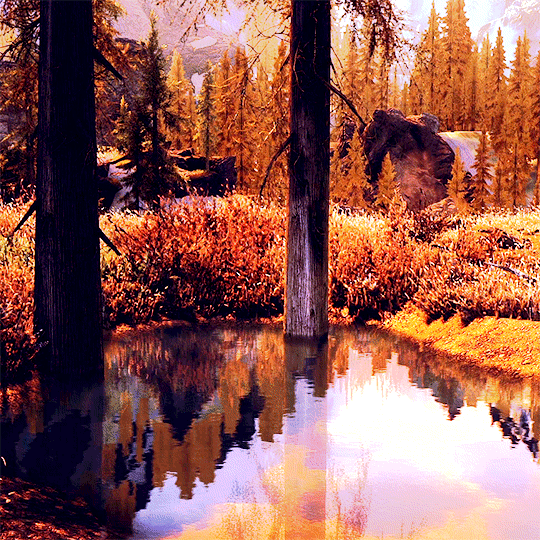

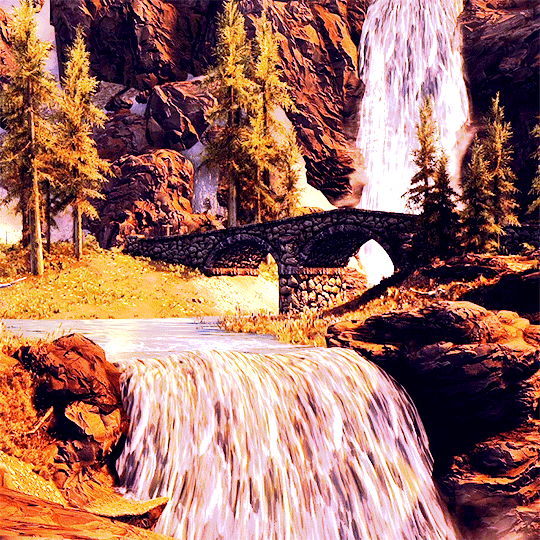
The Elder Scrolls V: Skyrim (2011-2021) ♡ dev. bethesda game studios
967 notes
·
View notes
Text










Went to the woods in the fog in search of a handsome leshy and his band of wolves and crows, but there was only the rustle of leaves and the call of little birds in the mist. Maybe he was out there and just didn’t fancy visitors on a freezing, foggy January afternoon. Can’t say I blame him.
(C) do not use, edit, reupload.
374 notes
·
View notes
Photo






I redid this older comic I made for my storytelling class based on this post. Have some cute wlw love in your day.
It’s hard, if I had more free time I could make it so pretty, this is what I could throw together for the assignment.
342K notes
·
View notes
Text
Rb if your account is safe space for
-LGBTQ+
-People from every nation
-All religions
-Dark skin people
-Asian people
-Uyghur Turks and Muslims
-People with mental disorders
-People with illness
-Neurodivergent people
21K notes
·
View notes
Text


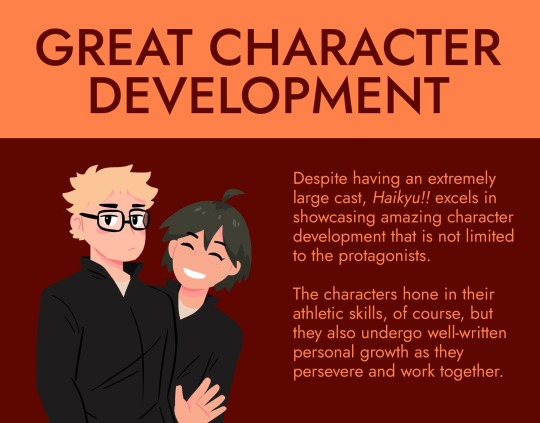
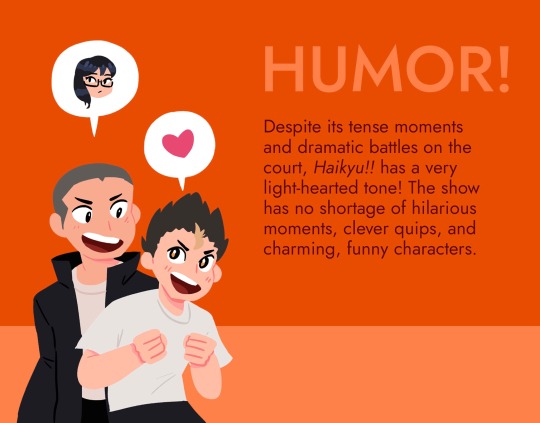


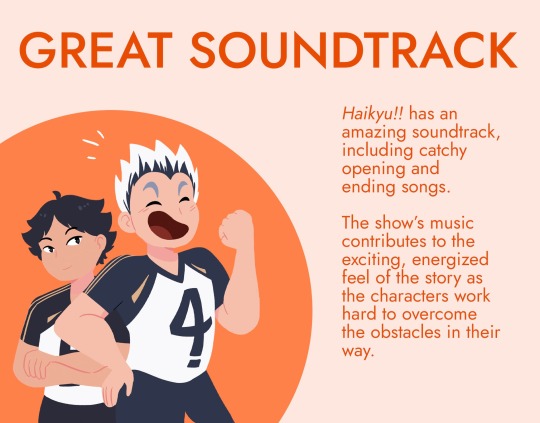

Special thanks to my big brother who got me to watch Haikyu!! this summer after I kept insisting I wanted nothing to do with volleyball (slide 6 is aimed at my slightly younger self haha)
I hope you all succeed in getting your friends and family to watch Haikyu!! It truly is a delightful show that has something special for everyone.
5K notes
·
View notes
Text
ways for your characters to meet + writing prompts
meet cute
your card declines and the person behind you offers to pay
you're the maid of honor at your best friend's wedding, your soon-to-be-lover is the best man
the coffee shop/café is packed with people and no free seats, you ask a stranger if you can sit at their table
we're at a get-together with mutual friends and the only ones without a date
a stranger notices you can't reach the top of the shelf, but before they can offer their help, you've accidentally gone and ripped down the entire bookshelf
you fall asleep on a stranger's shoulder on a long flight. when you wake up, you tell them they're free to use your shoulder as a pillow, which they agree to
you jump into a cab in New York City, but right as the Taxi driver is about to drive off, someone else jumps in
a mutual friend sets you up on a blind-date
while waiting in line, you start a conversation with the person in front of you,
coincidentally, we're both at a hotel, leaving our room at the same time. turns out we both had a one-night stand and it was terrible
for some reason you can't seem to navigate the map, so you ask a stranger for directions. they inform you you're holding the map upside down
you see a stranger sitting alone at a restaurant, and decide to join them
you're at a resort, and in desperate need to get away from your family. you hide in a wardrobe down in the lobby, and while in there, you discover that a stranger is also hiding there
you jump into a car thinking it's your friend's, only to find a stranger sitting in the passenger seat
you're stranded on the highway, struggling to change a tire. a car pulls over to help you, offering to drive you back into town when they deem your car undriveable
the hotel double-booked your room, you can either share it or sleep in the lobby
meet ugly
bumping into your soon-to-be lover on the street, spilling coffee all over their shirt
your friend has been pranking you all day, scaring you when you least expect it. when you go to pick up some food, somebody jumps out from behind you. thinking it's your friend, you turn around and slap them, only to find it's not your friend
you're at the store, arguing with a stranger over who should get to buy the last watermelon (or any other grocery)
you almost hit your soon-to-be lover with your car as they cross the street
''you took my parking spot'' ''I WAS HERE FIRST'' ''I WAS STANDING HERE WHEN YOU PULLED OVER. I HAD MY BLINKERS ON''
you bump into someone's car in the parking lot and they retaliate by bumping yours
you walk into a dressing room thinking it's unoccupied, but instead finds a man without his shirt on
your ex cheated on you, so you decide to go over to their house to cause some mishap, only to later on discover that your ex recently moved
i've been waiting in line for ten minutes and you decide to cut in front of me and i'm not very happy
you're at the bar, having just paid for a drink, only for someone to slide up next to you and take a sip of it
i've mistaken your apartment for my friend's, and has been banging on your door for the past ten minutes. you've finally had enough and open the door, screaming at me to leave you alone. then i start screaming, because it was a mistake. a couple minutes later, your neighbor flings their door open, scolding both of us for making a scene
3K notes
·
View notes
Text
need refs/inspo for period clothing?
here you go:
Medieval (9th-15th century):
10th century and earlier
Romance (1000-1250)
11th century
12th century
13th century
more 13th century
14th century
more 14th
15th century
and more 15th century
Gothic (1150-1550)
Renaissance (1520-1650)
16th & 17th century
16th century
more 16th
Tudors (1500-1550)
more Tudors
Elizabethan Period (1558-1603)
Jacobean Era (1603-1625)
17th century
more 17th century
and again
and even more
this won’t stop
Baroque (1600-1750)
Georgian Period (1714-1830):
18th century
more 18th century
18th century women’s fashion
18th century men’s fashion
Rococo (1720-1770)
Classicism (1770-1790)
children 18th-19th century
Regency Preiod (1811-1820)/ Empire (1800-1820s):
1790-1820s
more stuff on regency and georgian era
even more
that’s not enough regency
and more
how is there so much
early 19th century men’s wear
early 19th century women’s wear
Victorian Period (1837-1901):
Romantic Era (1820-1840s)
Civil War Era/1850-1860s
1870-1890s
more victorian
Edwardian Period (1901-1910):
1900-1910s
Belle Epoque (1880-1910s)
more edwardian/belle époque
Modern:
1910s-1920s [Fashion between the World Wars]
1920s
more roaring 20s
so much 20s
1920s hairstyles
1930s
1930-1940s
1930-1950s
1950s
more 50s
1960s
1960-1970s
1980s
lots of periods in one spot/fashion through centuries:
here, here, and here is almost everything (and properly ordered)
also here with lots of historic fashion magazines
historic fashion
costumes of antiquity
more historical clothing
history of fashion
more history of fashion
“vintage” clothing
historic costumes
children’s historical fashion/toys
details
historic wedding dresses
historic assecoires (hats, shoes…)
hats
masks
parasols
lots of embroidery/jewlery
it indeed is western/european centric, I’m sorry for that, but for other cultures I simply don’t have so many references
156K notes
·
View notes
Text
Writing advice you're not going to like.
People sometimes send me Asks wanting writing advice. I suck at it. I don’t really know how I do the writing, or how one should do the writing, or what one should do to get better at the writing. All I can ever think to say is “write a lot of stuff and you will get better at the writing.” Which is true, but hardly a bolt from the sky.
Well, as it turns out, I do have one piece of Legit Writing Advice, and I am going to share it with you, right now. If you were in any of my writing workshop groups at a con, you’ve heard this advice already.
Warning: you’re going to fucking hate it. But if you do it, you will thank me.
If you have a piece of fiction you’re serious about, something you might want to actually shop around, or just something you really are into and want to make it as good as you can…do NOT edit it.
Repeat. DO NOT EDIT.
REWRITE.
As in, print out the whole fucking thing and re-enter it, every word (or use two screens). Retype the whole thing. Recreate it from the ground up using your first draft as a template. Start with a blank page and re-enter every. single. word.
I hear you screaming. OH MY GOD THAT’S INSANE.
Yes. Yes, it is.
It is also the most powerful thing you will ever do for a piece of fiction that you are serious about.
Now, let’s get real. I don’t do this for most things. I don’t do it for my fanfiction. But if it’s something original, something I might like to get to a professional level - I do it. You absolutely COULD do it for fanfiction. It’s just up to you and how much time you want to sink into a piece.
You can edit, sure. But you WILL NOT get down to the level of change that needs to happen in a second draft. You will let things slide. Your eyes will miss things. You will say “eh, good enough.”
The first time I did this, on someone else’s advice, I was dubious. Within two pages, I was saying WHY HAVE I NOT BEEN DOING THIS ALL THE TIME. I was amazed at how much change was happening. By the time I got to the end, I had an entirely different novel than the one I’d started with. When you’re already re-entering every single word, it’s easy to make deep changes. You’ll reformat sentences, you’ll switch phrases around, you’ll massage your word choice. You’ll discover whole paragraphs that don’t need to be there at all because they became redundant. You’ll find dialogue exchanges that need reimagining. Whole plot points will suddenly be different, whole story arcs will reveal their flaws and get re-drawn.
You cannot get down to the fundamental level of change that’s required just by editing an existing document. You have to rebuild it if you really want your story to evolve. You will be AMAZED at the difference it will make.
It will take time. It will seem like a huge, Herculean task. I’m not saying it’s easy. It isn’t. But it is absolutely revolutionary.
Try it. I promise, you will see what I mean.
*PSA: Tipsy!Lori wrote this post. In case you couldn’t tell.
93K notes
·
View notes

